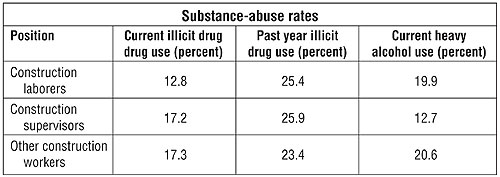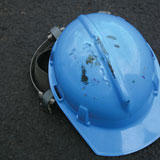Would you be surprised to learn nearly a quarter of your workers are illegal drug users?
Consider what a California-based contracting company discovered several years ago when it decided to prove its workers were not illegal drug users. On a given day following 30-day advance notice, employees were asked to volunteer for a drug test. Of the 179 people on the payroll, 80 volunteered. The urine samples were collected by an independent laboratory, tested and reported directly to the company. No names were used in the sample collection or reporting of the results. Three construction sites were chosen to represent a cross-section of employees from northern, central and southern California.
The results speak for themselves: Twenty-four percent—one quarter of the employee population—of the tests were positive for one or more illegal drugs. According to a drug-testing manual published by the California Associated General Contractors, from that group, 15 percent tested positive for marijuana and 10 percent tested positive for cocaine. And that was from a group of volunteers!
The drug problem
The U.S. has made progress in addressing its drug problem during the past 10 years, but, unfortunately, the problem has not gone away. The federal government's annual report about substance abuse indicates the seriousness of the issue.
For example, according to the National Survey of Drug Use and Health released in 2005 by the Substance Abuse and Mental Health Services Administration, Washington, D.C., there were about 19 million past-month illicit drug users 12 and older.

Some rates of substance abuse among different occupations in the construction industry
In addition, most binge drinkers and heavy alcohol users were employed. Among the 51.9 million adult binge drinkers (five or more drinks on at least one occasion in the past 30 days) in 2004, 41.2 million (79.3 percent) had either full- or part-time employment. Similarly, 12.7 million (79.5 percent) of the 16 million adult heavy drinkers (five or more drinks on at least five or more occasions in the past month) were employed.
Several national reports about teen substance abuse do not paint a promising picture of the near future. And, of course, a current teen drug user is tomorrow's job applicant.
The construction workplace
Also in the National Survey of Drug Use and Health, the federal government estimates a little more than 75 percent of all illicit drug users 18 and older are employed. And the industry often identified for having the highest rate of illicit drug users is the construction industry.
According to the U.S. Department of Labor's Substance Abuse Information Database Web site, said.dol.gov, a 1996 federal government survey, the last such survey conducted by the government, shows how serious the problem is for construction companies. Among full-time construction workers between the ages of 18 and 49, more than 12 percent reported illicit drug use during the month before the survey was conducted; almost 21 percent reported illicit drug use during the previous year. Additionally, about 13 percent admitted to being heavy alcohol users.
Some substance-abuse rates among different occupations in the construction industry are displayed in the figure.
Drug-abuse effects
Generally speaking, workers who abuse substances tend to be less productive; more likely to be involved in workplace confrontations and acts of violence; unreliable; and steal from their employers and others at a higher rate than their nonusing co-workers.
A compelling study by the U.S. Postal Service found that substance abusers, when compared with their nonabusing co-workers, are involved in 55 percent more accidents and sustain 85 percent more on-the-job injuries. Furthermore, the National Safety Council reported that 80 percent of those injured in "serious" drug-related accidents at work are not drug-abusing employees but innocent co-workers and others.
It also stands to reason that if the construction industry employs more drug users than other industries, the effects of drug abuse would be significant at construction sites. And given the safety-sensitive nature of the construction industry, the effects are most significant in the area of safety.
A graduate student from Cornell University, Ithaca, N.Y., found that construction laborers between 25 years old and 34 years old who have been treated for substance abuse have a time-loss injury rate of 23.6 per 100 full-time equivalent workers. That's nearly double the rate of nonabusers, who had a rate of 12.2 per 100 full-time equivalent workers.
Eighty-five percent of the cases involved treatment for alcohol abuse. The study concluded the difference between known substance abusers and nonabusers is "likely understated." According to "Construction Company Drug Testing Reduces Work Injuries, Study Finds," an article in the June 2000 issue of the Cornell Chronicle, the study observed that "Injuries were counted as related to substance abuse only after substance abuse was diagnosed, yet one-third of the substance abusers' work-related injuries occurred before diagnosis." The study only tracked union workers and substance abusers treated in programs paid for by union health insurance.
A solution
Because the construction industry especially is affected by drug abuse, you should be concerned about the issue and have an established comprehensive drug-free workplace program. Among the components of such a program is drug and alcohol testing.
Drug and alcohol testing has proved to be highly effective in deterring substance abuse and identifying those who need help. Testing is legal in every state though a handful of states regulate it (for more information, see "Be careful where you dig," September issue, page 42).
For many years, construction companies that conduct drug tests have used the services of laboratories certified by the federal government's Substance Abuse and Mental Health Services Administration to analyze all drug screens. And for many years, this was the best testing method available. However, though drug testing makes sense for many construction companies, waiting two days to four days for results from a lab is highly impractical. When a drug-test result is the only factor keeping a crew of new workers from starting a job, an immediate, accurate result is needed.
Rapid-result, on-site testing has become a popular alternative to traditional lab-based testing, especially for safety-sensitive industries such as the construction industry. Often, a construction company significantly can reduce the time it takes to conduct a test by using rapid-result testing. The results are available within minutes and, depending on the product being used, rapid-result testing is as accurate as the screening technologies used in laboratories. Also of significance, most rapid-result testing devices cost much less than a lab-based test, especially if the employer administers the test internally rather than relying on the services of a professional collector to administer the test.
A rapid-result drug test can be witnessed throughout every phase of the testing process, so there never is a question about a test's chain of custody. And because the analysis can be witnessed, there rarely is any confrontation between the tested worker and test administrator.
Specimen testing
Employers also now have options available in terms of what specimen to test. No longer is urine the only specimen recognized as an accurate medium for detecting drugs. Oral-fluid samples and hair samples also have proved to be effective in drug-abuse detection.
The key issue is the window of detection. A hair test can detect drug use back 90 days (though not for five days to seven days immediately after use) but is only available as a lab-based analysis. A urine test can be lab-based or rapid-result and detects drug use back three days to five days (though not several hours immediately after use). An oral-fluid test also is either lab-based or rapid-result but only can detect drug use for up to 24 hours. Oral-fluid testing can detect substances immediately after use; is the easiest to administer on-site; does not require secured bathrooms; the entire collection and analysis can be witnessed by the donor; and the shorter window of detection tends to be acceptable to unions. The accuracy of the different methods depends on the device being used, lab being used and drug for which an employee is being tested.
Choosing a method
A word of caution about rapid-result testing: Not all testing devices are created equal. Although their prices have decreased significantly during the past few years, the adage "you get what you pay for" often applies. Prices range from about $5 to $15 for the device; most providers will charge more for various support services, such as specimen collection, initial test result confirmation and verification, and data storage. When considering instant testing consider the following:
- Make sure your state allows it. Although most states have no restrictions on instant testing or oral-fluid testing, some states do. Check with your drug testing provider for a complete list.
- Look for urine-testing devices approved by the U.S. Food and Drug Administration (FDA). Instant oral-fluid testing has not passed FDA muster yet though there are several reliable products available.
- Limit your considerations to devices that come with independent scientific data to back up all accuracy claims. It's not enough to see it in writing; make sure the source is an independent, objective one.
- Try all devices under consideration in real work situations. Devices differ with regard to how they are administered, how results are read, how long it takes to get a result, etc. Make sure the device you're considering will work for you.
- Work with a provider that has been in the business more than a few months (and maybe even years). You're going to need technical, and perhaps legal, support. Not all providers have experts on hand to answer your questions.
Does it work?
In the construction industry, drug testing is credited with significant reductions in accidents. According to the Cornell University study cited earlier, construction companies that implement drug testing experience a 51 percent injury-rate reduction within two years of implementing a program compared with only a 14 percent injury-rate reduction in the average construction company in general during the same two-year period.
The study also found that "the average company that drug tests in the study sample experienced an 11.4 percent reduction in its workers' compensation experience modification rating factor. At the same time, companies in the study sample that did not employ drug testing saw no such decline."
Additionally, the report found construction industry employers believed drug-testing programs have a positive effect in "virtually every respect." The report cited "better overall safety of the work environment, reductions in workers' compensation costs and improved quality of job applicants as three of the most positive developments." Employers also said "drug testing contributed positively to a company's image and was an effective deterrent to workplace drug abuse."
And testing procedures may deter drug abusers from applying for a job at your company. According to a survey conducted by the government in 1997, 40 percent of full-time employees who admitted to being current illicit drug users said they were less likely to work for a company that conducted random drug testing. In addition, 30 percent said they were less likely to work for a company that conducted pre-employment drug testing.
Clean companies
Drug testing is an important, available resource, and rapid-response drug testing is an efficient and accurate tool for roofing contractors. Making the effort to identify drug-abusing employees will make your job site a safer and more productive place.
William F. Current is president of WFC & Associates, a drug-free workplace consulting firm based in Coral Springs, Fla.

